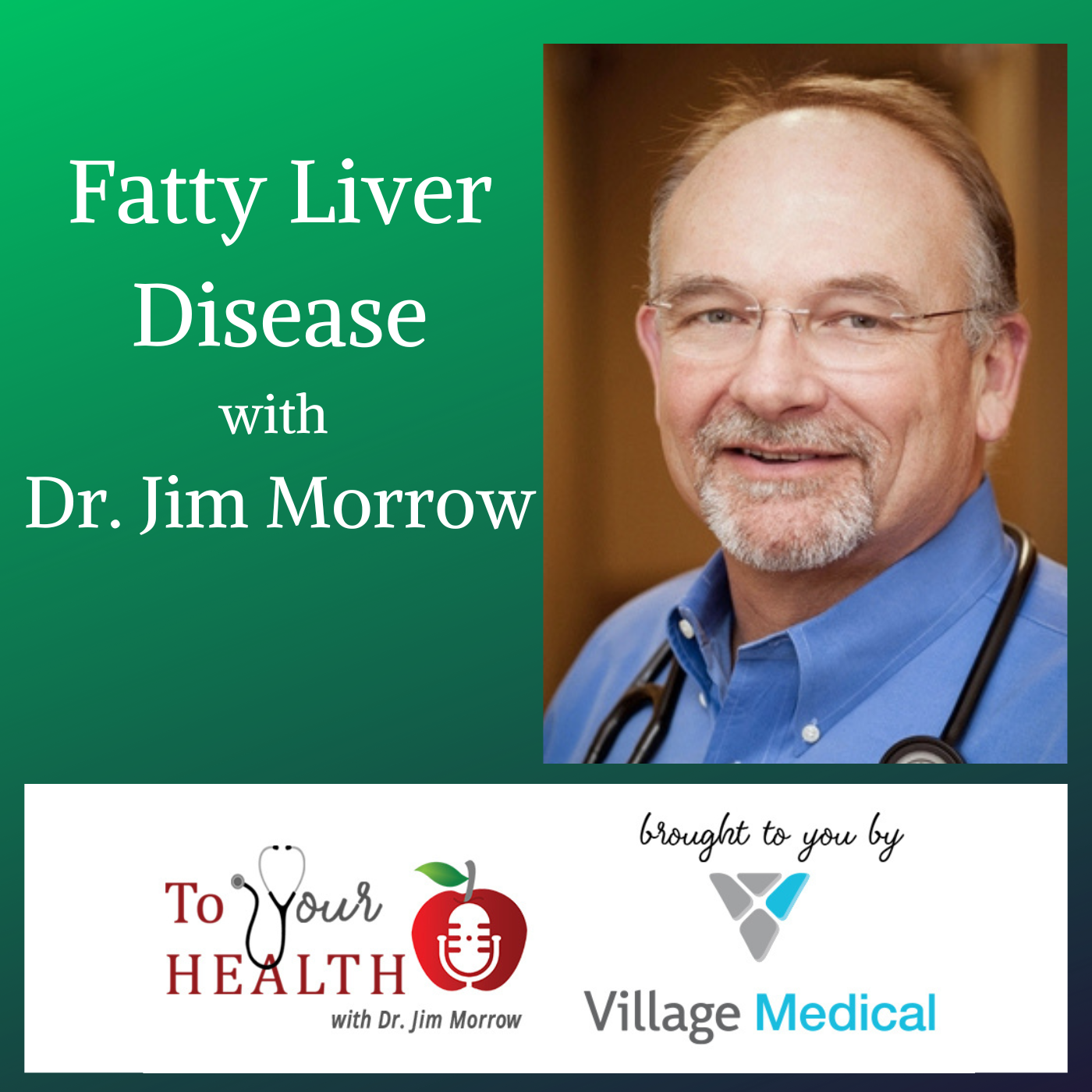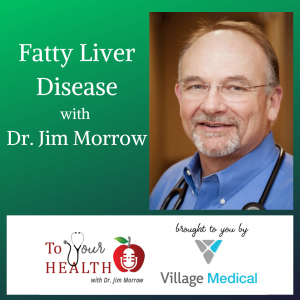
Fatty Liver Disease (Episode 88, To Your Health with Dr. Jim Morrow)
On this episode of To Your Health, Dr. Jim Morrow addressed fatty liver disease, which he says is fairly common. He explained what the liver does, what the disease is, and how it manifests itself. Dr. Morrow also covered the difference between alcohol-induced and non-alcohol related fatty liver disease, as well as its causes, diagnosis and prognosis, and more.
To Your Health is brought to you by Village Medical (formerly Morrow Family Medicine), which brings the care back to healthcare.
About Village Medical (formerly Morrow Family Medicine)
Village Medical, formerly Morrow Family Medicine, is an award-winning, state-of-the-art family practice with offices in Cumming and Milton, Georgia. The practice combines healthcare information technology with old-fashioned care to provide the type of care that many are in search of today. Two physicians, three physician assistants and two nurse practitioners are supported by a knowledgeable and friendly staff to make your visit to Village Medical one that will remind you of the way healthcare should be. At Village Medical, we like to say we are “bringing the care back to healthcare!” The practice has been named the “Best of Forsyth” in Family Medicine in all five years of the award, is a three-time consecutive winner of the “Best of North Atlanta” by readers of Appen Media, and the 2019 winner of “Best of Life” in North Fulton County.
Village Medical offers a comprehensive suite of primary care services including preventative care, treatment for illness and injury, and management of chronic conditions such as diabetes, congestive heart failure, chronic obstructive pulmonary disease (COPD) and kidney disease. Atlanta-area patients can learn more about the practice here.
Dr. Jim Morrow, Village Medical, and Host of To Your Health with Dr. Jim Morrow
 Dr. Jim Morrow is the founder of Morrow Family Medicine. He has been a trailblazer and evangelist in healthcare information technology, was named Physician IT Leader of the Year by HIMSS, a HIMSS Davies Award Winner, the Cumming-Forsyth Chamber of Commerce Steve Bloom Award Winner as Entrepreneur of the Year and he received a Phoenix Award as Community Leader of the Year from the Metro Atlanta Chamber of Commerce. He is married to Peggie Morrow and together they founded the Forsyth BYOT Benefit, a charity in Forsyth County to support students in need of technology and devices. They have two Goldendoodles, a gaggle of grandchildren and enjoy life on and around Lake Lanier.
Dr. Jim Morrow is the founder of Morrow Family Medicine. He has been a trailblazer and evangelist in healthcare information technology, was named Physician IT Leader of the Year by HIMSS, a HIMSS Davies Award Winner, the Cumming-Forsyth Chamber of Commerce Steve Bloom Award Winner as Entrepreneur of the Year and he received a Phoenix Award as Community Leader of the Year from the Metro Atlanta Chamber of Commerce. He is married to Peggie Morrow and together they founded the Forsyth BYOT Benefit, a charity in Forsyth County to support students in need of technology and devices. They have two Goldendoodles, a gaggle of grandchildren and enjoy life on and around Lake Lanier.
The complete show archive of To Your Health with Dr. Jim Morrow addresses a wide range of health and wellness topics.
Dr. Morrow’s Show Notes
FATTY LIVER DISEASE
What is the liver’s function?
Your liver is an essential organ with multiple life-supporting functions. The liver:
- Produces bile, which helps with digestion.
- Makes proteins for the body.
- Stores iron.
- Converts nutrients into energy.
- Creates substances that help your blood clot (stick together to heal wounds).
- Helps you resist infections by making immune factors and removing bacteria and toxins (substances that can harm your body) from your blood.
What is fatty liver disease?
- Fatty liver disease (steatosis) is a common condition caused by having too much fat build up in your liver.
- A healthy liver contains a small amount of fat.
- It becomes a problem when fat reaches 5% to 10% of your liver’s weight.
Why is fatty liver disease bad?
- In most cases, fatty liver disease doesn’t cause any serious problems or prevent your liver from functioning normally.
- But for 7% to 30% of people with the condition, fatty liver disease gets worse over time.
- It progresses through three stages:
- Your liver becomes inflamed (swollen), which damages its tissue. This stage is called steatohepatitis.
- Scar tissue forms where your liver is damaged. This process is called fibrosis.
- Extensive scar tissue replaces healthy tissue. At this point, you have cirrhosis of the liver.
Cirrhosis of the liver
- Cirrhosis of the liver is a result of severe damage to the liver.
- The hard scar tissue that replaces healthy liver tissue slows down the liver’s functioning.
- Eventually, it can block liver function entirely.
- Cirrhosis can lead to liver failure and liver cancer.
What are the forms of fatty liver disease?
- There are two main forms of fatty liver disease:
- Alcohol-induced fatty liver disease
- Alcohol-induced fatty liver disease is caused by regular alcohol consumption.
- About 5% of people in the U.S. have this form of liver disease.
- Non-alcohol related fatty liver disease
- Non-alcohol related fatty liver disease (NAFLD) isn’t related to alcohol consumption.
- The condition affects one in three adults and one in 10 children in the United States.
- Researchers haven’t found the exact cause of non-alcohol related fatty liver disease.
- Several factors, such as obesity and diabetes, can increase your risk.
- Non-alcohol related fatty liver disease (NAFLD) isn’t related to alcohol consumption.
- Alcohol-induced fatty liver disease
SYMPTOMS AND CAUSES
Who gets fatty liver disease?
- You have a greater chance of developing fatty liver disease if you:
- Are of Hispanic or Asian descent.
- Have completed menopause (your periods have stopped).
- Have obesity with a high level of belly fat.
- Have high blood pressure, diabetes or high cholesterol.
- Have obstructive sleep apnea (a blocked airway that causes breathing to stop and start during sleep).
What causes fatty liver disease?
- Some people get fatty liver disease without having any pre-existing conditions.
- But these risk factors make you more likely to develop it:
- Having overweight/obesity.
- Having Type 2 diabetes or insulin resistance.
- Having metabolic syndrome
- (insulin resistance,
- high blood pressure,
- high cholesterol
- and high triglyceride levels).
- Taking certain prescription medications,
- such as amiodarone, diltiazem, tamoxifen or steroids.
- But these risk factors make you more likely to develop it:
What are the symptoms of fatty liver disease?
- People with fatty liver disease often have no symptoms until the disease progresses to cirrhosis of the liver.
- If you do have symptoms, they may include:
- Abdominal pain or a feeling of fullness in the upper right side of the abdomen (belly).
- Nausea, loss of appetite or weight loss.
- Yellowish skin and whites of the eyes (jaundice).
- Swollen abdomen and legs (edema).
- Extreme tiredness or mental confusion.
- If you do have symptoms, they may include:
DIAGNOSIS AND TESTS
How is fatty liver disease diagnosed?
- Because this condition often has no symptoms, your doctor may be the first one to spot it.
- Higher levels of liver enzymes (elevated liver enzymes) that turn up on a blood test for other conditions may raise a red flag.
- Elevated liver enzymes are a sign your liver is injured.
- To make a diagnosis, your doctor may order:
- Ultrasound or computed tomography (CT scan) to get a picture of the liver.
- Liver biopsy (tissue sample) to determine how far advanced liver disease has progressed.
- FibroScan, a specialized ultrasound sometimes used instead of a liver biopsy to find out the amount of fat and scar tissue in the liver.
MANAGEMENT AND TREATMENT
How is fatty liver disease treated?
- There’s no medication specifically for this disease.
- Instead, doctors focus on helping you manage factors that contribute to the condition.
- They also recommend making lifestyle changes that can significantly improve your health.
- Treatment includes:
- Avoiding alcohol.
- Losing weight.
- Taking medications to manage diabetes, cholesterol and triglycerides (fat in the blood).
- Taking vitamin E
PREVENTION
How can fatty liver disease be prevented?
- The best way to avoid it is to do the things that maintain overall health:
- Stay at a healthy weight. If you have overweight/obesity, lose weight gradually.
- Exercise regularly.
- Limit your alcohol consumption.
- Take medications as prescribed.
OUTLOOK / PROGNOSIS
Can fatty liver disease be reversed?
- The liver has an amazing ability to repair itself.
- If you avoid alcohol or lose weight, it’s possible to reduce liver fat and inflammation and reverse early liver damage.
Will fatty liver disease kill you?
- Fatty liver disease doesn’t cause major problems for most people.
- However, it can turn into a more serious problem if it progresses into cirrhosis of the liver.
- Untreated cirrhosis of the liver eventually leads to liver failure or liver cancer.
- Your liver is an organ you can’t live without.
What is nonalcoholic fatty liver disease (NAFLD)?
- Nonalcoholic fatty liver disease (NAFLD) is a buildup of fat in the liver.
- It is a common condition.
- NAFLD can be harmless, but sometimes it may cause the liver to swell.
- Over time, this swelling can cause scarring in your liver (cirrhosis).
- The more scarring your liver has, the worse it functions.
Symptoms of NALFD?
- Many people do not have any symptoms of NAFLD.
- If you have NAFLD, you may feel fullness or pain in the middle or upper right side of the abdomen.
- You may feel extremely tired.
- Your belly may be swollen.
- You may have yellowing of your skin and eyes.
- If your NAFLD has progressed to cirrhosis, you may have more serious symptoms
- including fluid retention,
- internal bleeding,
- and mental confusion.
What causes NAFLD?
- Doctors don’t know exactly what causes NAFLD.
- They do know that NAFLD is linked to insulin resistance.
- Insulin resistance is when your body doesn’t respond well to insulin.
- This makes it more difficult for your body to regulate blood sugar.
- It is not caused by drinking alcohol.
How is NAFLD diagnosed?
- To diagnose NAFLD, your doctor may check your blood and order a scan of your liver.
- If your doctor thinks you may have a more severe liver disease,
- you may need a liver biopsy.
- In this procedure, your doctor inserts a needle through your skin and removes a small piece of tissue from your liver.
- This tissue is looked at under a microscope to check for signs of severe liver disease.
- If your doctor thinks you may have a more severe liver disease,
Can NAFLD be prevented or avoided?
- A wide range of things can increase your risk of NAFLD,
- including certain medicines
- and genetic disorders.
- The most common risk factors for NAFLD are
- obesity,
- diabetes,
- and high cholesterol levels.
- including certain medicines
NAFLD treatment
- People who have NAFLD usually do not need treatment.
- The most important thing is to focus on what has caused your NAFLD.
- Losing weight gradually (1 to 2 pounds per week) may reduce the amount of fat in your liver.
- However, losing weight quickly may make NAFLD worse.
- Ask your doctor for advice on how to lose weight in a safe and healthy way.
- If your cholesterol and blood sugar levels are high, your doctor may give you medicine to lower them.
- If a medicine you take is causing your NAFLD, your doctor may consider switching you to a different medicine.
Living with NAFLD
- For most people, NAFLD is harmless and does not cause serious health problems.
- NAFLD usually does not affect how well the liver works.
- However, in rare cases, NAFLD may stop the liver from working as it should.
- No one can tell for sure who will have liver problems from NAFLD.
- It is more likely to happen in people who have diabetes or who are very overweight.
- NAFLD usually does not affect how well the liver works.
credit: clevelandclinic.org















